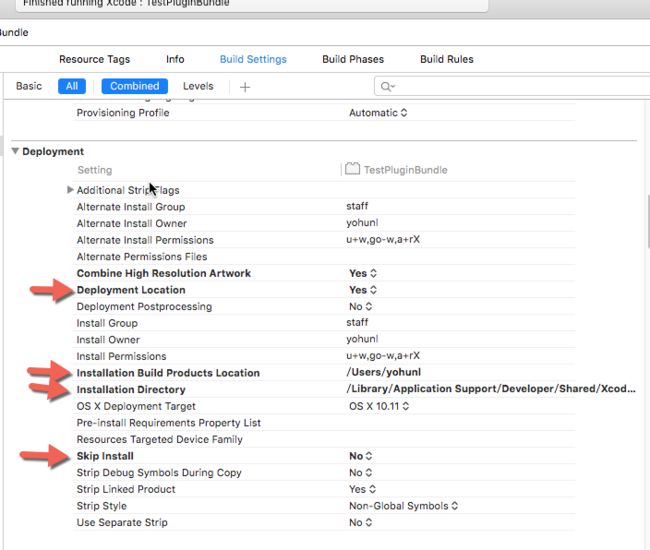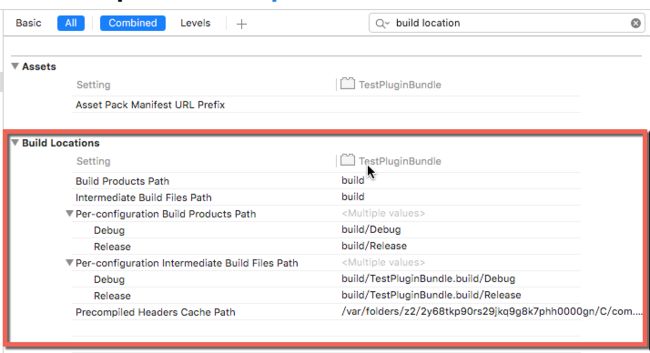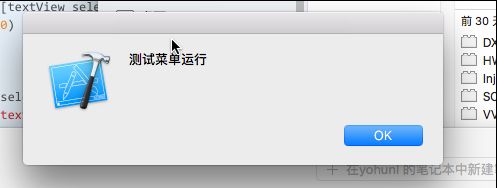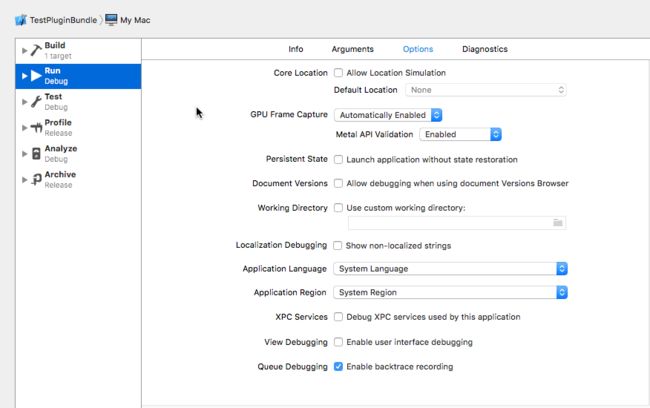iOS 插件制作
概述
我们平时也使用了很多的xcode插件,虽然官方对于插件制作没有提供任何支持,但是加载三方的插件,默认还是被允许的.第三方的插件,需要存放在 ~/Library/Application Support/Developer/Shared/Xcode/Plug-ins文件夹中,后缀名必须是.xcplugin (不过其实际上是一种bundle).
所以我们创建一个插件工程,直接创建bundle工程即可,然后通过修改后缀名为.xcplugin,将其放到~/Library/Application Support/Developer/Shared/Xcode/Plug-ins目录中就可以了
第一个demo插件功能:在xcode的edit菜单中加入一个叫做 测试菜单 的项目,当点击的时候,弹出一个警告框,显示一句话,完整的工程放在TestPluginBundle
详细过程
工程名称就是 TestPluginBundle
工程设置
插件工程和普通的bundle工程还是有区别的,所以需要进行特殊的设置
首先是工程的plist文件

添加 三项
XCPluginHasUI = NO
XC4Compatible = YES
DVTPlugInCompatibilityUUIDs 这是一个数组.数组内容字符串,指示了该插件兼容的xcode版本,只有对应版本的xcode的UIID加入这个数组了,插件才能被加载,否则,即使你将插件放入xcode的插件文件夹,插件也不会被加载的
那么怎么获取你当前版本的xcode的UUID呢?在terminal中输入 defaults read /Applications/Xcode.app/Contents/Info DVTPlugInCompatibilityUUID ,terminal会返回一串字符串给你,这就是你的Xcode的DVTPlugInCompatibilityUUID.
接下来是 Build Setting了


Installation Build Products Location 设置为 ${HOME} [显示的时候,显示的是你的用户目录],这个是products的根目录
Installation Directory 设置为 /Library/Application Support/Developer/Shared/Xcode/Plug-ins,这个是指定你的插件安装的目录. 注意,这里填入的其实是相对目录,插件的绝对目录是这样的,例如 /Users/yohunl/Library/Application Support/Developer/Shared/Xcode/Plug-ins/Alcatraz.xcplugin ,最后的绝对目录是 Installation Build Products Location和Installation Directory的结合,这也是为什么两者都要设置的原因
Deployment Location 设置为 YES,这个是指示该工程不使用设置里的build location,而是用Installation Directory来确定build后放哪儿

我们默认工程生成的相关文件放在哪.都是 Build Locations指示的,通过Deployment Location 设置为 YES告诉工程,我们不使用这个默认的设置,而是我们自定义的
Wrapper extension 设置为 xcplugin,后缀名必须为xcplugin,否则不会被加载
接下来就是插件的实现过程了
在工程中添加一个文件 ,名称为 TestPluginBundle (当然,名字随便什么都可以),在其中添加代码
@implementation TestPluginBundle+(void)pluginDidLoad:(NSBundle *)plugin { NSLog(@"插件运行了!"); [TestPluginBundle sharedInstance];}- (instancetype)init{ self = [super init]; if (self) { [[NSNotificationCenter defaultCenter] addObserver:self selector:@selector(didApplicationFinishLaunchingNotification:) name:NSApplicationDidFinishLaunchingNotification object:nil]; } return self;}- (void)didApplicationFinishLaunchingNotification:(NSNotification*)noti{ [[NSNotificationCenter defaultCenter] removeObserver:self name:NSApplicationDidFinishLaunchingNotification object:nil]; NSMenuItem *menuItem = [[NSApp mainMenu] itemWithTitle:@"Edit"]; if (menuItem) { [[menuItem submenu] addItem:[NSMenuItem separatorItem]]; NSMenuItem *actionMenuItem = [[NSMenuItem alloc] initWithTitle:@"测试菜单" action:@selector(doMenuAction) keyEquivalent:@""]; [actionMenuItem setTarget:self]; [[menuItem submenu] addItem:actionMenuItem]; }}- (void)doMenuAction{ NSAlert *alert = [[NSAlert alloc] init]; [alert setMessageText:@"测试菜单运行"]; [alert runModal];}- (void)dealloc{ [[NSNotificationCenter defaultCenter] removeObserver:self];}+ (instancetype)sharedInstance{ static id instance; static dispatch_once_t onceToken; dispatch_once(&onceToken, ^{ instance = [[self alloc] init]; }); return instance;}@end
ctrl+B来Build工程,查看路径下/Library/Application Support/Developer/Shared/Xcode/Plug-ins,可以看到我们的插件TestPluginBundle.xcplugin存在了,接下来,重启xcode

点击 测试菜单

可能你 会说,这样虽然是起作用了,但是,难道开发一个插件工程,没打单步调试么???,当然不是啊
编辑工程的scheme,将Executable设置为Xcode.app,意思是工程调试的时候挂载到xcode中

将Options下面的Core Location,XPC Services,View Debugging前面的勾都去掉,否则,你调试的时候,可能会直接crash

当设置完后,你的工程的scheme的图标会从bundle图标变为xcode的图标
![]()
再运行(这里是运行了,不是编译了)
不出意外的话,会出现xode启动另外一个xcode,接下来和你普通的调试工程就是一样的了!
说了这么多,其实只是想让你明白一个插件的初始化的配置,调试等
上面的过程,已经有国外大神制作成了一个 工程模板了,https://github.com/kattrali/Xcode-Plugin-Template 其支持OC和Swift,当你安装它后,会在新建工程时候,看到 Xcode Plugin模板,使用这个模板创建一个新工程,以上的配置等,就都设置好了,直接运行就是一个demo了.


